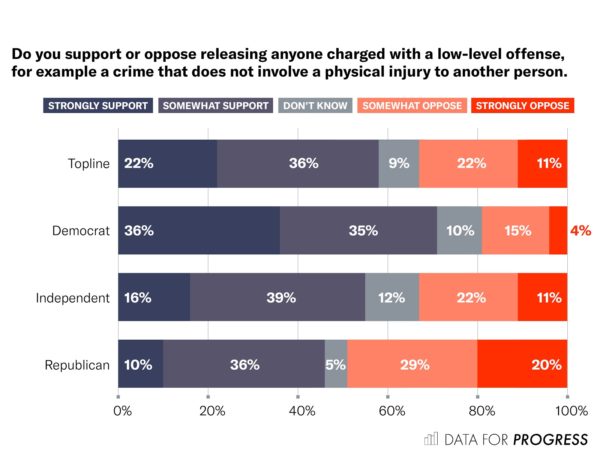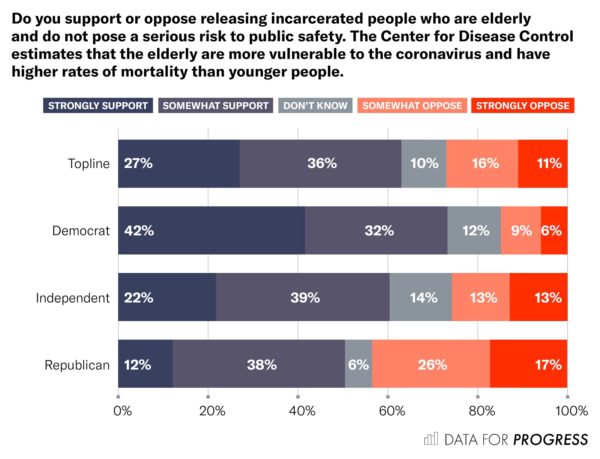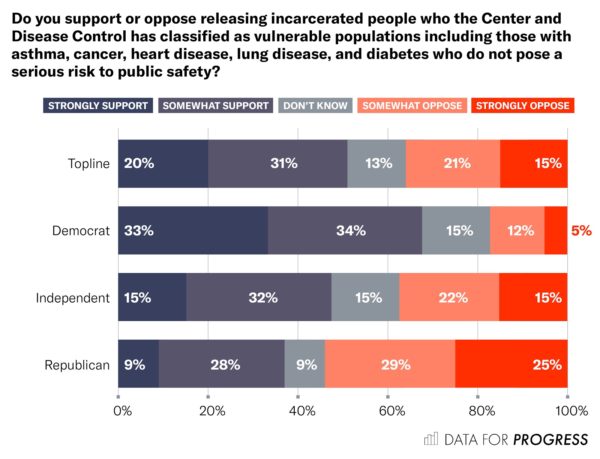As Pandemic Rages, Voters Support Releasing People From Jails And Prisons
Detaining people who pose no danger to the public in crowded, unsanitary jails and prisons not only endangers those who are incarcerated, it also subjects staff and the broader community to needless risk as new, more virulent strains of COVID-19 make their way into the United States.

Over the past year, we have seen the dangers of COVID-19 outbreaks in jails and prisons, where more than 570,000 people have contracted the virus and at least 2,500 residents and staff have died. But as the pandemic rages on, even jurisdictions that safely reduced their jail populations in order to mitigate risk have since resumed prior practices, filling their jails and excarberating already heightened risks. Detaining people who pose no danger to the public in crowded, unsanitary jails and prisons not only endangers those who are incarcerated, it also subjects staff and the broader community to needless risk as new, more virulent strains of COVID-19 make their way into the United States.
In a number of big jurisdictions, jail populations are exceeding pre-pandemic levels and pushing capacity limits. Florida’s Broward County, which reduced its jail population early in the pandemic to under 3,000 “for the first time in decades,” now has about 3,500 people incarcerated—putting its jails at nearly 80 percent full. Even more dire are the situations in Texas’s Harris County, which has jailed more than 9,000 people and has just 25 beds left, and California’s Los Angeles County, where more people are being held before trial for longer than this time last year, before the pandemic.
A new national poll by Data for Progress and The Lab, a policy vertical of The Appeal, shows that voters nationwide support releasing people from jails and prisons as a means of containing the spread of COVID-19 and protecting public health. These latest findings echo results from April 2020 showing bipartisan public support for addressing jails as disease vectors by reducing incarcerated populations.
With the specter of new, especially contagious strains of COVID, the advent of vaccinations, and proof that reducing jail and prison populations promotes rather than harms public health, it’s no surprise that voters continue to support decarceration. Last April just over half of respondents favored releasing incarcerated people with low-level charges that do not involve physical harm. Today, nearly 60 percent of voters nationwide support those conditions of release. Majority support for releasing people within six months of completing a sentence remained stable at 55 percent, while the majority backing the release of elderly incarcerated people grew by five points—from 58 to 63 percent of voters nationwide. Similarly, support for the use of summons or tickets instead of arrests remained strong, with 65 percent of voters (including 54 percent of Republicans) backing the proposal, compared to 63 percent in April.
Full Results:
- 58 percent of voters, including 55 percent of independents and nearly half of Republicans, support releasing anyone charged with a low-level offense.

- 63 percent of voters, including 50 percent of Republicans, support releasing eldery people who do not pose a serious risk to public safety.

- 55 percent of voters, including 57 percent of independents, support releasing people who are within 6 months of completing their sentence.

- 65 percent of voters, including 62 percent of independents and 54 percent of Republicans, support encouraging law enforcement officers to use summons or tickets as alternatives to arrests and jail.

- 51 percent of voters support releasing people whom the Centers for Disease Control & Prevention (CDC) has determined are especially vulnerable to COVID-19 and who do not pose a public safety risk.

Polling Methodology
From January 29 to February 1, 2021, Data for Progress conducted a survey of 1124 likely voters nationally using web panel respondents. The sample was weighted to be representative of likely voters by age, gender, education, race, and voting history. The survey was conducted in English. The margin of error is ±2.9 percentage points.

